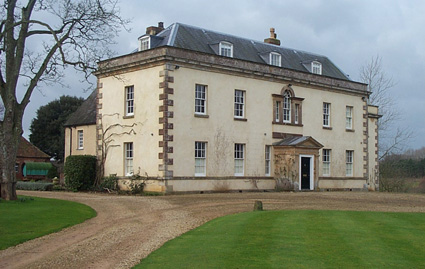
|
|
Another of the Bayntun's great houses was called Battle House, situated north of the Church of St. Nicholas in the village of Bromham. This house was built on the site of the Abbey Stewards' house. Little has changed in its appearance over the centuries and today you can easily picture what life must have been like in the 18th century when the horse-drawn carriages arrived at the front of this famous house, and the sound they made on the rough gravel driveway, still evident today. It took its name from the Manor of Bromham Battle and Battle Abbey. The lordship of Bromham had previously belonged to Earl Harold and afterwards the Manor and church were given by King William II (Rufus) to the Benedictine Monastery of St. Martin at Battle, Co. Sussex. It is said that the lawn in front of the house should be stained with gore, but for the lapse of time, as the captive Royalists were placed there to be shot at during the Cromwellian period (1644 - 1648). Later it became the Dower House of the Bayntun family. Whenever the head of the family died, the eldest son inherited and took over the family mansion – Spye Park House and lived there. The widow of the deceased then moved out and into the Battle House. The rear of the house dates from c15th/16th century but the front addition is an 18th century stucco-fronted building of two storeys with a hipped slated roof, plain parapet, three segmental-headed dormers and moulded cornice. An extension conforming to the original work has been added on the right - a one studio room and was added in 1909. After their marriage in 1777 Sir Andrew Bayntun Rolt (1755-1816) and his wife, Lady Maria Coventry resided at Battle House. Sir William Napier (1785 - 1860), historian of the Peninsular Wars, also lived there from 1820 to 1831. When John Bayntun Starky (1834-1872) married Frances Grubbe in 1857, his mother Charlotte Wyndham, moved out of Spye Park House and resided at Battle House from then until her death in 1896. The Crown Commissioners acquired most of the Bayntun Starky lands in lieu of debts on 19th December 1862. These lands are still the property of the Crown today. The rest, the mansion house at Spye Park, 6 farms, 50 houses and large tracts of land were sold by the creditors of John Bayntun Starky on 3rd August 1864 to John Spicer. John Bayntun Starky received no money from this sale however and Battle House too became the property of the Spicer family and from that date forward, Charlotte Wyndham became a tenant of John Spicer, but continued to reside at Battle House. John Bayntun Starky immigrated to New South Wales in Australia and died there in 1872 and at this time, Charlotte Wyndham wrote to his wife Frances Anne and asked if she and the children would come back to England to live with her at Battle House. She did return to England but never resided at Battle House. Kelly's Directory of Wiltshire 1880 lists a Mrs. Starky living at Battle House at the time of its publication. This was most likely Charlotte Wyndham. A much later owner, between about 1896 and 1912, was the Punch cartoonist Leonard Raven Hill. An extract from an interview with him in The Idler Vol. XV 1899 said there were about 20 rooms in the house.
|


